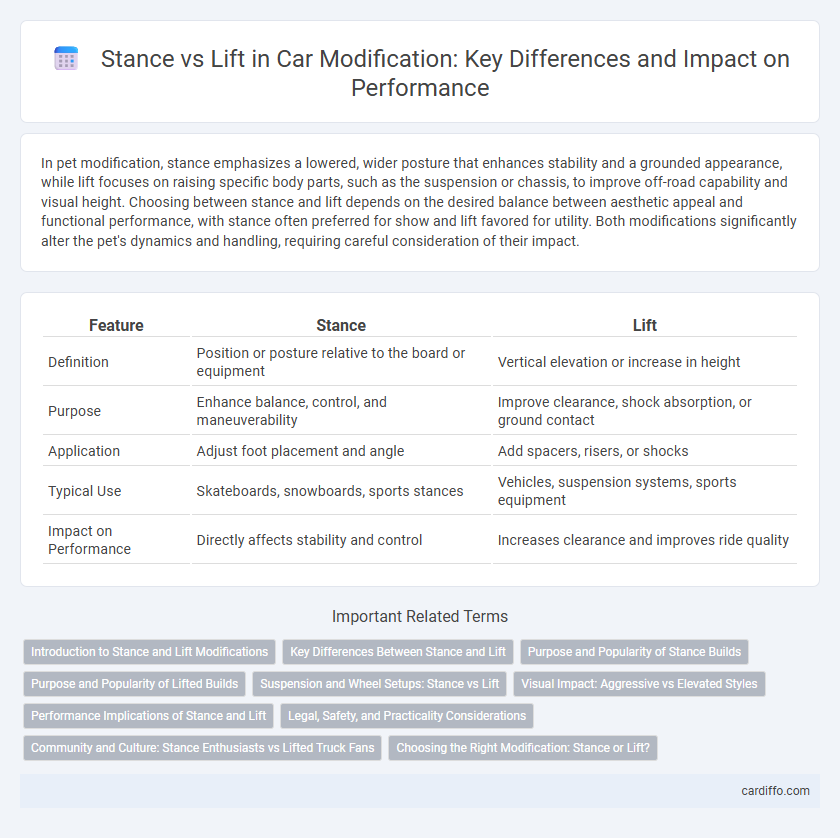In pet modification, stance emphasizes a lowered, wider posture that enhances stability and a grounded appearance, while lift focuses on raising specific body parts, such as the suspension or chassis, to improve off-road capability and visual height. Choosing between stance and lift depends on the desired balance between aesthetic appeal and functional performance, with stance often preferred for show and lift favored for utility. Both modifications significantly alter the pet's dynamics and handling, requiring careful consideration of their impact.
Table of Comparison
| Feature | Stance | Lift |
|---|---|---|
| Definition | Position or posture relative to the board or equipment | Vertical elevation or increase in height |
| Purpose | Enhance balance, control, and maneuverability | Improve clearance, shock absorption, or ground contact |
| Application | Adjust foot placement and angle | Add spacers, risers, or shocks |
| Typical Use | Skateboards, snowboards, sports stances | Vehicles, suspension systems, sports equipment |
| Impact on Performance | Directly affects stability and control | Increases clearance and improves ride quality |
Introduction to Stance and Lift Modifications
Stance and lift modifications significantly impact vehicle performance by altering ground clearance and center of gravity, enhancing off-road capabilities and visual appeal. Adjusting stance involves changing wheel alignment, track width, or tire size to improve handling and stability, while lift modifications increase suspension height, allowing for larger tires and better obstacle clearance. Both modifications require careful consideration of suspension geometry and safety standards to maintain optimal driving dynamics.
Key Differences Between Stance and Lift
Stance refers to the positioning and alignment of the feet and body before initiating a movement, impacting balance and stability. Lift involves the actual motion of raising or elevating an object or body part, emphasizing strength and technique. Key differences lie in stance's role in preparation and positioning versus lift's role in execution and force application.
Purpose and Popularity of Stance Builds
Stance modifications prioritize improved stability, control, and aesthetics, making them highly popular among enthusiasts who seek both functional and visual enhancement. Lift builds appeal primarily to off-road and utility users focused on increased ground clearance and rugged terrain capability. The purpose of stance builds centers on lowering the vehicle's ride height and optimizing wheel fitment for street performance and show-quality appearance.
Purpose and Popularity of Lifted Builds
Lifted builds prioritize increased ground clearance, enhancing off-road capability and rugged terrain performance. This modification is popular among off-road enthusiasts and truck owners seeking improved approach angles and obstacle navigation. The purpose of a lifted stance extends beyond aesthetics, emphasizing functionality and better drivetrain articulation.
Suspension and Wheel Setups: Stance vs Lift
Suspension and wheel setups heavily influence vehicle stance versus lift, where stance optimizes for aesthetics and handling with wider wheels and lower suspension, while lift prioritizes off-road capability by increasing ride height and suspension travel. Stance modifications often involve adjustable coilovers or air suspension combined with camber adjustments to achieve flush wheel fitment. Lift kits use longer shocks, spacers, or upgraded springs to enhance ground clearance, wheel articulation, and tire clearance for rugged terrains.
Visual Impact: Aggressive vs Elevated Styles
Stance modifications lower a vehicle's center of gravity, creating an aggressive visual impact through widened wheels and reduced wheel gap that emphasize sportiness and ground-hugging aesthetics. Lift modifications increase ride height, producing an elevated style that enhances off-road capability and offers a commanding view while projecting ruggedness and dominance. The choice between stance and lift significantly influences a vehicle's presence, balancing aggressive ground- hugging appeal against imposing height and off-road readiness.
Performance Implications of Stance and Lift
Adjusting stance and lift significantly impacts vehicle handling and overall performance by altering the center of gravity and suspension dynamics. A wider stance enhances stability and cornering grip, while lift affects approach and departure angles, crucial for off-road capability. Balancing stance width and lift height optimizes traction and ride quality without compromising fuel efficiency or aerodynamics.
Legal, Safety, and Practicality Considerations
Modifying a vehicle's stance or lift directly impacts legal compliance related to height restrictions and safety regulations governed by transportation authorities. Safety considerations include altered center of gravity affecting handling, braking distance, and tire wear, which must meet standards for roadworthiness. Practicality involves balancing aesthetic goals with functional factors such as suspension durability, ground clearance, and daily drivability to ensure modifications remain safe and legal.
Community and Culture: Stance Enthusiasts vs Lifted Truck Fans
Stance enthusiasts prioritize lowered suspension and wide wheel fitment to achieve an aggressive, ground-hugging look that reflects a tight-knit community valuing precision and artistic expression in automotive customization. Lifted truck fans focus on increased ground clearance and off-road capability, fostering a culture centered around ruggedness, adventure, and communal events like truck shows and trail rides. Both communities emphasize identity and passion through distinct vehicle modifications that reinforce their shared values and social bonds.
Choosing the Right Modification: Stance or Lift?
Selecting the appropriate modification depends on individual biomechanics and activity requirements, with stance adjustments optimizing balance and alignment, while lifts address height discrepancies and reduce joint strain. Evaluating specific goals such as improving gait efficiency or alleviating pressure on lower limbs guides the decision between stance modifications and lift interventions. Professional assessment ensures customized solutions that enhance comfort, stability, and overall mobility.
stance vs lift Infographic

 cardiffo.com
cardiffo.com